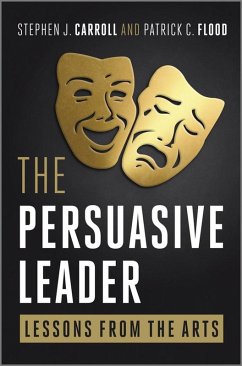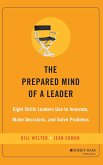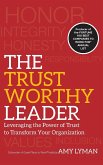- Gebundenes Buch
- Merkliste
- Auf die Merkliste
- Bewerten Bewerten
- Teilen
- Produkt teilen
- Produkterinnerung
- Produkterinnerung
The communication aspect of leadership - to actively engage your followers and achieve understanding and motivation whilst making the message memorable - has never been more important. Using vivid lessons and examples from spheres outside business organization, The Persuasive Leader explores the leader's role as a communicator and teaches the fundamental principles of successful leadership.
This book provides insights and principles about persuasive leadership from a broad range of human experiences. It draws on examples of persuasive leaders and persuasive leadership principles from the…mehr
Andere Kunden interessierten sich auch für
![The Right Leader The Right Leader]() Nathaniel C. StoddardThe Right Leader25,99 €
Nathaniel C. StoddardThe Right Leader25,99 €![The Unfinished Leader The Unfinished Leader]() David L. DotlichThe Unfinished Leader24,99 €
David L. DotlichThe Unfinished Leader24,99 €![The 60 Second Leader The 60 Second Leader]() Phil DouradoThe 60 Second Leader19,99 €
Phil DouradoThe 60 Second Leader19,99 €![The Enlightened Leader The Enlightened Leader]() Peter ten HoopenThe Enlightened Leader38,99 €
Peter ten HoopenThe Enlightened Leader38,99 €![The Prepared Mind of a Leader The Prepared Mind of a Leader]() Bill WelterThe Prepared Mind of a Leader29,99 €
Bill WelterThe Prepared Mind of a Leader29,99 €![The Trustworthy Leader The Trustworthy Leader]() Amy LymanThe Trustworthy Leader24,99 €
Amy LymanThe Trustworthy Leader24,99 €![The Transformational Leader The Transformational Leader]() Noel M. TichyThe Transformational Leader27,99 €
Noel M. TichyThe Transformational Leader27,99 €-
-
-
The communication aspect of leadership - to actively engage your followers and achieve understanding and motivation whilst making the message memorable - has never been more important. Using vivid lessons and examples from spheres outside business organization, The Persuasive Leader explores the leader's role as a communicator and teaches the fundamental principles of successful leadership.
This book provides insights and principles about persuasive leadership from a broad range of human experiences. It draws on examples of persuasive leaders and persuasive leadership principles from the performing arts, the fine arts, literature, philosophical writings, and biography. The authors use their unconventional material to explore themes such as moral leadership, toxic leadership, learning from failures, 'distributed' leadership, leading for results and the leader as a mentor and counsellor.
Hinweis: Dieser Artikel kann nur an eine deutsche Lieferadresse ausgeliefert werden.
This book provides insights and principles about persuasive leadership from a broad range of human experiences. It draws on examples of persuasive leaders and persuasive leadership principles from the performing arts, the fine arts, literature, philosophical writings, and biography. The authors use their unconventional material to explore themes such as moral leadership, toxic leadership, learning from failures, 'distributed' leadership, leading for results and the leader as a mentor and counsellor.
Hinweis: Dieser Artikel kann nur an eine deutsche Lieferadresse ausgeliefert werden.
Produktdetails
- Produktdetails
- Verlag: Wiley & Sons
- 2. Aufl.
- Seitenzahl: 288
- Erscheinungstermin: 30. August 2010
- Englisch
- Abmessung: 229mm x 160mm x 23mm
- Gewicht: 567g
- ISBN-13: 9780470688281
- ISBN-10: 0470688289
- Artikelnr.: 29929684
- Herstellerkennzeichnung
- Libri GmbH
- Europaallee 1
- 36244 Bad Hersfeld
- gpsr@libri.de
- Verlag: Wiley & Sons
- 2. Aufl.
- Seitenzahl: 288
- Erscheinungstermin: 30. August 2010
- Englisch
- Abmessung: 229mm x 160mm x 23mm
- Gewicht: 567g
- ISBN-13: 9780470688281
- ISBN-10: 0470688289
- Artikelnr.: 29929684
- Herstellerkennzeichnung
- Libri GmbH
- Europaallee 1
- 36244 Bad Hersfeld
- gpsr@libri.de
Stephen J. Carroll is a retired professor emeritus at the University of Maryland, who now works as a private consultant. During his career he has authored twelve books on psychology and organizational behaviour. He has served as a consultant to more than 30 industrial and government organizations and is a regular speaker at the University of Maryland and Syracuse University executive courses. He is best known for his books on performance assessment and leadership. He first developed the idea for this book in his courses for company executives where he found they responded particularly well to the case examples from the arts and from day to day life. Patrick C Flood is an Academic Fellow at Cambridge University. He has worked at the London Business School, University of Maryland, University of Limerick, Dublin City University and the London School of Economics. He is known primarily for his work on leadership teams and firm performance. His books include Effective Top Management Teams (2001, Blackwelll; Managing Strategy Implementation (with S.J.Carroll, Blackwell, 2000) (5000 copies sold over life) and Managing without Traditional Methods (Addison Wesley, 1996). He is currently external examiner at SAID business school and consults for the following companies: Pernod Ricard-Irish Distillers; Nypro-Clinton(US); Hewlett Packard (UK), Wang, Paul Partnership and VEC, Novartis, Nortel, ICL (UK), NHS(UK).
Foreword by Denise M. Rousseau xvi
Preface xvii
Acknowledgements xviii
About the authors xix
1 Persuasive leadership in life and work 1
Beginning cases 2
What is leadership? 4
Persuasive leadership in a new world 5
A newer focus on emotions and logic 6
Leadership as a social role in all living groups 6
Leadership legacies 7
Leadership goals 8
Leadership sub-roles 9
Leadership in changing crcumstances 9
Leader agendas 10
Leadership and the arts 10
Parents as persuasive leaders 11
Leadership and strategies 11
Do leaders need charisma? 12
Persuasion as a key to all leadership efforts 13
Leaders as coherent wholes 13
Learning from examples 13
Types of persuasion settings 14
Types of Leadership 15
Leadership skills as identified in the arts and humanities 15
Do we need empirical studies of leadership? 16
Leaders and ethical behaviours 17
Leaders as examples of persuasive and moral principles 17
2 Usingaesthetics and the arts in persuasive leadership 21
Beginning cases 22
Leaders using the arts 24
What are the arts? 25
Practical use of the arts 25
The aesthetic response 26
Aesthetics and human evolution 27
Unity among the arts 27
Performance art 28
Leader-managers as architects 28
The orchestra conductor metaphor 29
Music in aesthetics 30
Humans as artists 31
Theatrical principles in leadership 32
Fictional versus actual leaders 33
Behaving like an artist 34
3 Usingwords effectively in persuasive speech and writing 37
Beginning cases 38
Evolution of language 39
Importance of word choice 39
Power of words to evoke emotion 40
Aesthetic versus non-aesthetic language 41
Function of fictional stories 41
Use of stories in persuasion 42
Delivering words effectively 42
Audience reactions to words 45
Words reflect characteristics of the speaker 45
Being open-minded in one's communications 46
4 Persuasive leadership and rhetoric principles 49
Beginning cases 50
Persuasion principles from philosophy 51
Persuasion in literature 52
Henry V 53
Julius Caesar 55
Joshua Chamberlain 56
Discussion of speeches 58
5 Persuasive leadership-planningconsiderations 63
Beginning cases 64
Studying the prospective audience 65
Building credibility 66
Obtain endorsements by influential persons 66
Build competence and coalitions 67
Gather facts and arguments in favor of goals 67
Plan for creating arousal/activation and more memorable messages 68
Planning for message content 68
Preparation 69
Practice 69
Choose optimum timing and setting 70
Emotional appeals 70
Use of dramatic principles in persuasion planning 70
Creating an engaging character-yourself 71
Learning acting skills 71
Process of planning 72
Using the arts in planning 72
6 Audience characteristics 77
Beginning cases 78
Audience characteristics 78
Audience to leader effects 79
Use of participation 80
Audience concerns 82
Psychological needs of the audience 82
Effect of cultural differences in audience responses 83
Motivational propensities in an audience 83
Occupational differences 84
Gender, ethnic, racial, and age differences 84
7 Leader-follower emotional ties 89
Beginning cases 90
Leader-follower attraction 92
Leader-follower bonding 93
Narcissistic behaviour 93
Attraction to morality 94
Attractiveness versus behaviour 94
Similarity 95
Openness and attraction 96
Optimistic and hopeful leaders 96
Respect for differences 96
8 Creatingpositive responses in sub-leaders and followers 99
Beginning cases 100
Leading sub-leaders 101
Counselling group members as individuals 102
Creating positive emotional states 103
Leaders as role models 105
Positive psychology 106
Optimism in the arts 108
Adversity coaching 108
Matching individuals and groups with appropriate tasks 109
Social barriers to persuasion 109
9 Persuasive leadership and change 113
Beginning cases 114
Change as a constant 115
Some fundamental causes of resistance to change efforts 116
Importance of feelings of self-efficacy in the motivation to change 117
Leader effectiveness versus likeability 117
Leadership and admiration-Benjamin Franklin 118
Franklin's targeted virtues 119
Using goals in change 120
Handling multiple factors in change 120
Self-leadership and change 121
Psychotherapy as an aid to change 121
Creating positive emotions 122
How small changes can have big effects 122
10 Strategic plans as a persuasive tool 125
Beginning cases 126
What are strategies? 127
Importance of acceptance of strategies 127
Credibility in the strategic planning process 128
Strategic plans and goal setting 128
Importance of self-perceived efficacy in goal achievement 129
Visioning and goal setting 130
Follow-up activities in strategic implementation 131
11 Harmful persuasion 135
Beginning case 136
Doing harm with persuasion 136
Types of harm 137
Why do such persuasive leaders act the way they do? 138
Confronting evil 138
Why is harmful persuasion accepted? 138
Standing up to injustice 139
Helping orientations 139
The role of deception in harmful persuasion 141
Deceptive messages well delivered 142
12 Self-leadership 145
Beginning cases 146
Leadership and self-management 147
Political liberty 147
Freedom in organizations 148
Trends in self-direction in several fields 149
Self-direction in parenting and preparation for self-direction 149
Therapy and other individual change programmes 149
Differential degrees of self-leadership and wasted human assets 150
Self-management and human respect and dignity 150
Self-leadership and the professional 151
13 Persuasive variations in different settings 153
Beginning cases 154
Persuasion in the courtroom 156
The law as a symbol of justice 158
Persuasion in the medical community 158
Persuasion in the home 160
Architecture 161
Philanthropic and artistic organizations 161
In the political arena 161
14 Achievingtrust and cooperation 165
Beginning cases 166
Leadership issues in cooperation 167
Reactions to authority 168
Origins of trust 169
Types of trust 170
Follower and leader needs 172
Explaining and fostering cooperation among group members 172
15 The noble persuasive leader 179
Beginning cases 180
What is nobility? 182
Roots of noble behaviour 182
Religion and nobility 183
Nobility in business enterprises 184
Nobility as a social class 184
Noble behaviour in the form of altruism and helping 185
The appeal of noble leaders 186
Immoral leaders 186
What are immoral practices in terms of morality within organizations? 187
Moral development 188
16 Leadership emergence 191
Beginning cases 192
Choosing leaders 194
Situational factors in persuasive leader emergence and effectiveness 194
Some indicators of leader emergence and success 195
Leaders as independent visionaries 198
Persuasiveness in leader effectiveness 198
Leader-follower interactions 199
Mindsets of effective leaders 199
What do prospective followers want in a leader? 200
Leadership changes 201
17 Handlingproblems and failure 203
Beginning cases 204
What are problems and failures? 206
Failures due to a changing world 207
Causes of persuasion failures 208
Persuasion failures mixed with successes 208
Persuasion failures due to competing social cultures 208
Politics and persuasion failures 209
Personal characteristics in reacting to problems and failures 210
Role of arrogance and hubris in failures 210
18 Why become a persuasive leader? 215
Beginning cases 216
Persuasiveness as a means to significant ends 218
Changing life roles 219
The human search for happiness 219
What is true (rather than perceived) happiness? 220
Expectations and happiness 221
Good and evil ends 221
Redeeming oneself 222
The ideal persuasive leader in fiction 223
Search for a meaningful life 225
Expectations and success 226
Avoidance of regrets/remorse 226
Persuasion and performance and a changed self-identity 227
Role of positive values 228
Life as a search for beauty 229
Summary 229
End cases 230
Exercise 231
Works cited 232
Appendices.
A Brief look at some of the relevant arts and humanities 233
B Happiness 239
C Behaviours of the best and worst bosses 243
D Selected social science theories relevant to persuasive leadership 247
Bibliography 253
Index 259
Preface xvii
Acknowledgements xviii
About the authors xix
1 Persuasive leadership in life and work 1
Beginning cases 2
What is leadership? 4
Persuasive leadership in a new world 5
A newer focus on emotions and logic 6
Leadership as a social role in all living groups 6
Leadership legacies 7
Leadership goals 8
Leadership sub-roles 9
Leadership in changing crcumstances 9
Leader agendas 10
Leadership and the arts 10
Parents as persuasive leaders 11
Leadership and strategies 11
Do leaders need charisma? 12
Persuasion as a key to all leadership efforts 13
Leaders as coherent wholes 13
Learning from examples 13
Types of persuasion settings 14
Types of Leadership 15
Leadership skills as identified in the arts and humanities 15
Do we need empirical studies of leadership? 16
Leaders and ethical behaviours 17
Leaders as examples of persuasive and moral principles 17
2 Usingaesthetics and the arts in persuasive leadership 21
Beginning cases 22
Leaders using the arts 24
What are the arts? 25
Practical use of the arts 25
The aesthetic response 26
Aesthetics and human evolution 27
Unity among the arts 27
Performance art 28
Leader-managers as architects 28
The orchestra conductor metaphor 29
Music in aesthetics 30
Humans as artists 31
Theatrical principles in leadership 32
Fictional versus actual leaders 33
Behaving like an artist 34
3 Usingwords effectively in persuasive speech and writing 37
Beginning cases 38
Evolution of language 39
Importance of word choice 39
Power of words to evoke emotion 40
Aesthetic versus non-aesthetic language 41
Function of fictional stories 41
Use of stories in persuasion 42
Delivering words effectively 42
Audience reactions to words 45
Words reflect characteristics of the speaker 45
Being open-minded in one's communications 46
4 Persuasive leadership and rhetoric principles 49
Beginning cases 50
Persuasion principles from philosophy 51
Persuasion in literature 52
Henry V 53
Julius Caesar 55
Joshua Chamberlain 56
Discussion of speeches 58
5 Persuasive leadership-planningconsiderations 63
Beginning cases 64
Studying the prospective audience 65
Building credibility 66
Obtain endorsements by influential persons 66
Build competence and coalitions 67
Gather facts and arguments in favor of goals 67
Plan for creating arousal/activation and more memorable messages 68
Planning for message content 68
Preparation 69
Practice 69
Choose optimum timing and setting 70
Emotional appeals 70
Use of dramatic principles in persuasion planning 70
Creating an engaging character-yourself 71
Learning acting skills 71
Process of planning 72
Using the arts in planning 72
6 Audience characteristics 77
Beginning cases 78
Audience characteristics 78
Audience to leader effects 79
Use of participation 80
Audience concerns 82
Psychological needs of the audience 82
Effect of cultural differences in audience responses 83
Motivational propensities in an audience 83
Occupational differences 84
Gender, ethnic, racial, and age differences 84
7 Leader-follower emotional ties 89
Beginning cases 90
Leader-follower attraction 92
Leader-follower bonding 93
Narcissistic behaviour 93
Attraction to morality 94
Attractiveness versus behaviour 94
Similarity 95
Openness and attraction 96
Optimistic and hopeful leaders 96
Respect for differences 96
8 Creatingpositive responses in sub-leaders and followers 99
Beginning cases 100
Leading sub-leaders 101
Counselling group members as individuals 102
Creating positive emotional states 103
Leaders as role models 105
Positive psychology 106
Optimism in the arts 108
Adversity coaching 108
Matching individuals and groups with appropriate tasks 109
Social barriers to persuasion 109
9 Persuasive leadership and change 113
Beginning cases 114
Change as a constant 115
Some fundamental causes of resistance to change efforts 116
Importance of feelings of self-efficacy in the motivation to change 117
Leader effectiveness versus likeability 117
Leadership and admiration-Benjamin Franklin 118
Franklin's targeted virtues 119
Using goals in change 120
Handling multiple factors in change 120
Self-leadership and change 121
Psychotherapy as an aid to change 121
Creating positive emotions 122
How small changes can have big effects 122
10 Strategic plans as a persuasive tool 125
Beginning cases 126
What are strategies? 127
Importance of acceptance of strategies 127
Credibility in the strategic planning process 128
Strategic plans and goal setting 128
Importance of self-perceived efficacy in goal achievement 129
Visioning and goal setting 130
Follow-up activities in strategic implementation 131
11 Harmful persuasion 135
Beginning case 136
Doing harm with persuasion 136
Types of harm 137
Why do such persuasive leaders act the way they do? 138
Confronting evil 138
Why is harmful persuasion accepted? 138
Standing up to injustice 139
Helping orientations 139
The role of deception in harmful persuasion 141
Deceptive messages well delivered 142
12 Self-leadership 145
Beginning cases 146
Leadership and self-management 147
Political liberty 147
Freedom in organizations 148
Trends in self-direction in several fields 149
Self-direction in parenting and preparation for self-direction 149
Therapy and other individual change programmes 149
Differential degrees of self-leadership and wasted human assets 150
Self-management and human respect and dignity 150
Self-leadership and the professional 151
13 Persuasive variations in different settings 153
Beginning cases 154
Persuasion in the courtroom 156
The law as a symbol of justice 158
Persuasion in the medical community 158
Persuasion in the home 160
Architecture 161
Philanthropic and artistic organizations 161
In the political arena 161
14 Achievingtrust and cooperation 165
Beginning cases 166
Leadership issues in cooperation 167
Reactions to authority 168
Origins of trust 169
Types of trust 170
Follower and leader needs 172
Explaining and fostering cooperation among group members 172
15 The noble persuasive leader 179
Beginning cases 180
What is nobility? 182
Roots of noble behaviour 182
Religion and nobility 183
Nobility in business enterprises 184
Nobility as a social class 184
Noble behaviour in the form of altruism and helping 185
The appeal of noble leaders 186
Immoral leaders 186
What are immoral practices in terms of morality within organizations? 187
Moral development 188
16 Leadership emergence 191
Beginning cases 192
Choosing leaders 194
Situational factors in persuasive leader emergence and effectiveness 194
Some indicators of leader emergence and success 195
Leaders as independent visionaries 198
Persuasiveness in leader effectiveness 198
Leader-follower interactions 199
Mindsets of effective leaders 199
What do prospective followers want in a leader? 200
Leadership changes 201
17 Handlingproblems and failure 203
Beginning cases 204
What are problems and failures? 206
Failures due to a changing world 207
Causes of persuasion failures 208
Persuasion failures mixed with successes 208
Persuasion failures due to competing social cultures 208
Politics and persuasion failures 209
Personal characteristics in reacting to problems and failures 210
Role of arrogance and hubris in failures 210
18 Why become a persuasive leader? 215
Beginning cases 216
Persuasiveness as a means to significant ends 218
Changing life roles 219
The human search for happiness 219
What is true (rather than perceived) happiness? 220
Expectations and happiness 221
Good and evil ends 221
Redeeming oneself 222
The ideal persuasive leader in fiction 223
Search for a meaningful life 225
Expectations and success 226
Avoidance of regrets/remorse 226
Persuasion and performance and a changed self-identity 227
Role of positive values 228
Life as a search for beauty 229
Summary 229
End cases 230
Exercise 231
Works cited 232
Appendices.
A Brief look at some of the relevant arts and humanities 233
B Happiness 239
C Behaviours of the best and worst bosses 243
D Selected social science theories relevant to persuasive leadership 247
Bibliography 253
Index 259
Foreword by Denise M. Rousseau xvi
Preface xvii
Acknowledgements xviii
About the authors xix
1 Persuasive leadership in life and work 1
Beginning cases 2
What is leadership? 4
Persuasive leadership in a new world 5
A newer focus on emotions and logic 6
Leadership as a social role in all living groups 6
Leadership legacies 7
Leadership goals 8
Leadership sub-roles 9
Leadership in changing crcumstances 9
Leader agendas 10
Leadership and the arts 10
Parents as persuasive leaders 11
Leadership and strategies 11
Do leaders need charisma? 12
Persuasion as a key to all leadership efforts 13
Leaders as coherent wholes 13
Learning from examples 13
Types of persuasion settings 14
Types of Leadership 15
Leadership skills as identified in the arts and humanities 15
Do we need empirical studies of leadership? 16
Leaders and ethical behaviours 17
Leaders as examples of persuasive and moral principles 17
2 Usingaesthetics and the arts in persuasive leadership 21
Beginning cases 22
Leaders using the arts 24
What are the arts? 25
Practical use of the arts 25
The aesthetic response 26
Aesthetics and human evolution 27
Unity among the arts 27
Performance art 28
Leader-managers as architects 28
The orchestra conductor metaphor 29
Music in aesthetics 30
Humans as artists 31
Theatrical principles in leadership 32
Fictional versus actual leaders 33
Behaving like an artist 34
3 Usingwords effectively in persuasive speech and writing 37
Beginning cases 38
Evolution of language 39
Importance of word choice 39
Power of words to evoke emotion 40
Aesthetic versus non-aesthetic language 41
Function of fictional stories 41
Use of stories in persuasion 42
Delivering words effectively 42
Audience reactions to words 45
Words reflect characteristics of the speaker 45
Being open-minded in one's communications 46
4 Persuasive leadership and rhetoric principles 49
Beginning cases 50
Persuasion principles from philosophy 51
Persuasion in literature 52
Henry V 53
Julius Caesar 55
Joshua Chamberlain 56
Discussion of speeches 58
5 Persuasive leadership-planningconsiderations 63
Beginning cases 64
Studying the prospective audience 65
Building credibility 66
Obtain endorsements by influential persons 66
Build competence and coalitions 67
Gather facts and arguments in favor of goals 67
Plan for creating arousal/activation and more memorable messages 68
Planning for message content 68
Preparation 69
Practice 69
Choose optimum timing and setting 70
Emotional appeals 70
Use of dramatic principles in persuasion planning 70
Creating an engaging character-yourself 71
Learning acting skills 71
Process of planning 72
Using the arts in planning 72
6 Audience characteristics 77
Beginning cases 78
Audience characteristics 78
Audience to leader effects 79
Use of participation 80
Audience concerns 82
Psychological needs of the audience 82
Effect of cultural differences in audience responses 83
Motivational propensities in an audience 83
Occupational differences 84
Gender, ethnic, racial, and age differences 84
7 Leader-follower emotional ties 89
Beginning cases 90
Leader-follower attraction 92
Leader-follower bonding 93
Narcissistic behaviour 93
Attraction to morality 94
Attractiveness versus behaviour 94
Similarity 95
Openness and attraction 96
Optimistic and hopeful leaders 96
Respect for differences 96
8 Creatingpositive responses in sub-leaders and followers 99
Beginning cases 100
Leading sub-leaders 101
Counselling group members as individuals 102
Creating positive emotional states 103
Leaders as role models 105
Positive psychology 106
Optimism in the arts 108
Adversity coaching 108
Matching individuals and groups with appropriate tasks 109
Social barriers to persuasion 109
9 Persuasive leadership and change 113
Beginning cases 114
Change as a constant 115
Some fundamental causes of resistance to change efforts 116
Importance of feelings of self-efficacy in the motivation to change 117
Leader effectiveness versus likeability 117
Leadership and admiration-Benjamin Franklin 118
Franklin's targeted virtues 119
Using goals in change 120
Handling multiple factors in change 120
Self-leadership and change 121
Psychotherapy as an aid to change 121
Creating positive emotions 122
How small changes can have big effects 122
10 Strategic plans as a persuasive tool 125
Beginning cases 126
What are strategies? 127
Importance of acceptance of strategies 127
Credibility in the strategic planning process 128
Strategic plans and goal setting 128
Importance of self-perceived efficacy in goal achievement 129
Visioning and goal setting 130
Follow-up activities in strategic implementation 131
11 Harmful persuasion 135
Beginning case 136
Doing harm with persuasion 136
Types of harm 137
Why do such persuasive leaders act the way they do? 138
Confronting evil 138
Why is harmful persuasion accepted? 138
Standing up to injustice 139
Helping orientations 139
The role of deception in harmful persuasion 141
Deceptive messages well delivered 142
12 Self-leadership 145
Beginning cases 146
Leadership and self-management 147
Political liberty 147
Freedom in organizations 148
Trends in self-direction in several fields 149
Self-direction in parenting and preparation for self-direction 149
Therapy and other individual change programmes 149
Differential degrees of self-leadership and wasted human assets 150
Self-management and human respect and dignity 150
Self-leadership and the professional 151
13 Persuasive variations in different settings 153
Beginning cases 154
Persuasion in the courtroom 156
The law as a symbol of justice 158
Persuasion in the medical community 158
Persuasion in the home 160
Architecture 161
Philanthropic and artistic organizations 161
In the political arena 161
14 Achievingtrust and cooperation 165
Beginning cases 166
Leadership issues in cooperation 167
Reactions to authority 168
Origins of trust 169
Types of trust 170
Follower and leader needs 172
Explaining and fostering cooperation among group members 172
15 The noble persuasive leader 179
Beginning cases 180
What is nobility? 182
Roots of noble behaviour 182
Religion and nobility 183
Nobility in business enterprises 184
Nobility as a social class 184
Noble behaviour in the form of altruism and helping 185
The appeal of noble leaders 186
Immoral leaders 186
What are immoral practices in terms of morality within organizations? 187
Moral development 188
16 Leadership emergence 191
Beginning cases 192
Choosing leaders 194
Situational factors in persuasive leader emergence and effectiveness 194
Some indicators of leader emergence and success 195
Leaders as independent visionaries 198
Persuasiveness in leader effectiveness 198
Leader-follower interactions 199
Mindsets of effective leaders 199
What do prospective followers want in a leader? 200
Leadership changes 201
17 Handlingproblems and failure 203
Beginning cases 204
What are problems and failures? 206
Failures due to a changing world 207
Causes of persuasion failures 208
Persuasion failures mixed with successes 208
Persuasion failures due to competing social cultures 208
Politics and persuasion failures 209
Personal characteristics in reacting to problems and failures 210
Role of arrogance and hubris in failures 210
18 Why become a persuasive leader? 215
Beginning cases 216
Persuasiveness as a means to significant ends 218
Changing life roles 219
The human search for happiness 219
What is true (rather than perceived) happiness? 220
Expectations and happiness 221
Good and evil ends 221
Redeeming oneself 222
The ideal persuasive leader in fiction 223
Search for a meaningful life 225
Expectations and success 226
Avoidance of regrets/remorse 226
Persuasion and performance and a changed self-identity 227
Role of positive values 228
Life as a search for beauty 229
Summary 229
End cases 230
Exercise 231
Works cited 232
Appendices.
A Brief look at some of the relevant arts and humanities 233
B Happiness 239
C Behaviours of the best and worst bosses 243
D Selected social science theories relevant to persuasive leadership 247
Bibliography 253
Index 259
Preface xvii
Acknowledgements xviii
About the authors xix
1 Persuasive leadership in life and work 1
Beginning cases 2
What is leadership? 4
Persuasive leadership in a new world 5
A newer focus on emotions and logic 6
Leadership as a social role in all living groups 6
Leadership legacies 7
Leadership goals 8
Leadership sub-roles 9
Leadership in changing crcumstances 9
Leader agendas 10
Leadership and the arts 10
Parents as persuasive leaders 11
Leadership and strategies 11
Do leaders need charisma? 12
Persuasion as a key to all leadership efforts 13
Leaders as coherent wholes 13
Learning from examples 13
Types of persuasion settings 14
Types of Leadership 15
Leadership skills as identified in the arts and humanities 15
Do we need empirical studies of leadership? 16
Leaders and ethical behaviours 17
Leaders as examples of persuasive and moral principles 17
2 Usingaesthetics and the arts in persuasive leadership 21
Beginning cases 22
Leaders using the arts 24
What are the arts? 25
Practical use of the arts 25
The aesthetic response 26
Aesthetics and human evolution 27
Unity among the arts 27
Performance art 28
Leader-managers as architects 28
The orchestra conductor metaphor 29
Music in aesthetics 30
Humans as artists 31
Theatrical principles in leadership 32
Fictional versus actual leaders 33
Behaving like an artist 34
3 Usingwords effectively in persuasive speech and writing 37
Beginning cases 38
Evolution of language 39
Importance of word choice 39
Power of words to evoke emotion 40
Aesthetic versus non-aesthetic language 41
Function of fictional stories 41
Use of stories in persuasion 42
Delivering words effectively 42
Audience reactions to words 45
Words reflect characteristics of the speaker 45
Being open-minded in one's communications 46
4 Persuasive leadership and rhetoric principles 49
Beginning cases 50
Persuasion principles from philosophy 51
Persuasion in literature 52
Henry V 53
Julius Caesar 55
Joshua Chamberlain 56
Discussion of speeches 58
5 Persuasive leadership-planningconsiderations 63
Beginning cases 64
Studying the prospective audience 65
Building credibility 66
Obtain endorsements by influential persons 66
Build competence and coalitions 67
Gather facts and arguments in favor of goals 67
Plan for creating arousal/activation and more memorable messages 68
Planning for message content 68
Preparation 69
Practice 69
Choose optimum timing and setting 70
Emotional appeals 70
Use of dramatic principles in persuasion planning 70
Creating an engaging character-yourself 71
Learning acting skills 71
Process of planning 72
Using the arts in planning 72
6 Audience characteristics 77
Beginning cases 78
Audience characteristics 78
Audience to leader effects 79
Use of participation 80
Audience concerns 82
Psychological needs of the audience 82
Effect of cultural differences in audience responses 83
Motivational propensities in an audience 83
Occupational differences 84
Gender, ethnic, racial, and age differences 84
7 Leader-follower emotional ties 89
Beginning cases 90
Leader-follower attraction 92
Leader-follower bonding 93
Narcissistic behaviour 93
Attraction to morality 94
Attractiveness versus behaviour 94
Similarity 95
Openness and attraction 96
Optimistic and hopeful leaders 96
Respect for differences 96
8 Creatingpositive responses in sub-leaders and followers 99
Beginning cases 100
Leading sub-leaders 101
Counselling group members as individuals 102
Creating positive emotional states 103
Leaders as role models 105
Positive psychology 106
Optimism in the arts 108
Adversity coaching 108
Matching individuals and groups with appropriate tasks 109
Social barriers to persuasion 109
9 Persuasive leadership and change 113
Beginning cases 114
Change as a constant 115
Some fundamental causes of resistance to change efforts 116
Importance of feelings of self-efficacy in the motivation to change 117
Leader effectiveness versus likeability 117
Leadership and admiration-Benjamin Franklin 118
Franklin's targeted virtues 119
Using goals in change 120
Handling multiple factors in change 120
Self-leadership and change 121
Psychotherapy as an aid to change 121
Creating positive emotions 122
How small changes can have big effects 122
10 Strategic plans as a persuasive tool 125
Beginning cases 126
What are strategies? 127
Importance of acceptance of strategies 127
Credibility in the strategic planning process 128
Strategic plans and goal setting 128
Importance of self-perceived efficacy in goal achievement 129
Visioning and goal setting 130
Follow-up activities in strategic implementation 131
11 Harmful persuasion 135
Beginning case 136
Doing harm with persuasion 136
Types of harm 137
Why do such persuasive leaders act the way they do? 138
Confronting evil 138
Why is harmful persuasion accepted? 138
Standing up to injustice 139
Helping orientations 139
The role of deception in harmful persuasion 141
Deceptive messages well delivered 142
12 Self-leadership 145
Beginning cases 146
Leadership and self-management 147
Political liberty 147
Freedom in organizations 148
Trends in self-direction in several fields 149
Self-direction in parenting and preparation for self-direction 149
Therapy and other individual change programmes 149
Differential degrees of self-leadership and wasted human assets 150
Self-management and human respect and dignity 150
Self-leadership and the professional 151
13 Persuasive variations in different settings 153
Beginning cases 154
Persuasion in the courtroom 156
The law as a symbol of justice 158
Persuasion in the medical community 158
Persuasion in the home 160
Architecture 161
Philanthropic and artistic organizations 161
In the political arena 161
14 Achievingtrust and cooperation 165
Beginning cases 166
Leadership issues in cooperation 167
Reactions to authority 168
Origins of trust 169
Types of trust 170
Follower and leader needs 172
Explaining and fostering cooperation among group members 172
15 The noble persuasive leader 179
Beginning cases 180
What is nobility? 182
Roots of noble behaviour 182
Religion and nobility 183
Nobility in business enterprises 184
Nobility as a social class 184
Noble behaviour in the form of altruism and helping 185
The appeal of noble leaders 186
Immoral leaders 186
What are immoral practices in terms of morality within organizations? 187
Moral development 188
16 Leadership emergence 191
Beginning cases 192
Choosing leaders 194
Situational factors in persuasive leader emergence and effectiveness 194
Some indicators of leader emergence and success 195
Leaders as independent visionaries 198
Persuasiveness in leader effectiveness 198
Leader-follower interactions 199
Mindsets of effective leaders 199
What do prospective followers want in a leader? 200
Leadership changes 201
17 Handlingproblems and failure 203
Beginning cases 204
What are problems and failures? 206
Failures due to a changing world 207
Causes of persuasion failures 208
Persuasion failures mixed with successes 208
Persuasion failures due to competing social cultures 208
Politics and persuasion failures 209
Personal characteristics in reacting to problems and failures 210
Role of arrogance and hubris in failures 210
18 Why become a persuasive leader? 215
Beginning cases 216
Persuasiveness as a means to significant ends 218
Changing life roles 219
The human search for happiness 219
What is true (rather than perceived) happiness? 220
Expectations and happiness 221
Good and evil ends 221
Redeeming oneself 222
The ideal persuasive leader in fiction 223
Search for a meaningful life 225
Expectations and success 226
Avoidance of regrets/remorse 226
Persuasion and performance and a changed self-identity 227
Role of positive values 228
Life as a search for beauty 229
Summary 229
End cases 230
Exercise 231
Works cited 232
Appendices.
A Brief look at some of the relevant arts and humanities 233
B Happiness 239
C Behaviours of the best and worst bosses 243
D Selected social science theories relevant to persuasive leadership 247
Bibliography 253
Index 259








